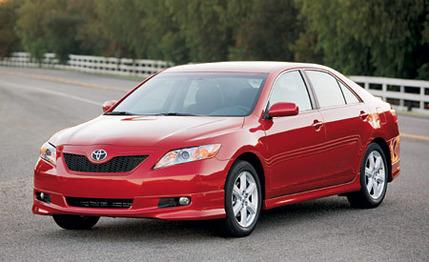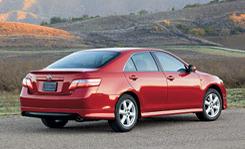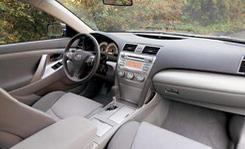 Road Test
Road Test
There was this famous masochist, the joke goes, who liked nothing better than to take a cold shower on a freezing winter morning. So he took a warm one instead.
Get it? Well, we're not into deferred gratification to nearly the same extent as that fellow, so Toyota's much-anticipated sixth-generation Camry seems a peculiar paradox in our book. On the one hand, the '07 Camry is Toyota's usual blend of careful engineering, scrupulous development, and meticulous assembly. On the one hand, the '07 Camry SE model -- in both 2.4-liter four-cylinder and 3.5-liter V-6 versions -- has been deliberately defined in this latest generation as something sportier than the rest of the Camry range. On the other, the company's obsession with safety has negated all that.
The SE's chassis benefits from unique sport tuning, with 15-percent-higher spring rates, special shocks that offer up to 50-percent-firmer damping at low piston speeds, a stiffer front anti-roll bar, and stiffer bushings on the rear suspension arms. In addition, there are body reinforcements not seen on lesser Camrys, including an underfloor brace, a V-brace behind the rear seatback (precluding the folding rear seats available in other Camrys), and thicker body-side brackets.
Cosmetically, the SE models can be recognized by their unique grille and headlamps, front and rear fascias, rocker panels, and 17-inch alloy wheels with 55-series summer tires. There is even a specific aerodynamic package for the SE, with an underengine panel plus rear-floor and fuel-tank covers that have longitudinal fins like you see on race-car underbody diffusers.
So, the SE trim level is clearly a big deal on a model that has a reputation as America's bestselling family runabout. But here's the tantalizing paradox: You can't get at the real fun. The car's stability-and-traction-control system steps in at the slightest hint of tire scrub and slows everything down. It won't tolerate an aggressive launch, and if you snap-shift the car into second gear and cop a tiny chirp of wheelspin, it slaps your wrist with a half-second of nothing. And it can't be switched off.
 Oh, all those fine suspension tweaks work great in the hills. The grip is pretty good at 0.82 g on the skidpad -- where you ride the razor's edge between slip angles to stop Mr. Party Pooper from slowing you down -- and the firm chassis discipline controls ride motions admirably. But again, the car's new athletic allure teases the driver with responsive steering, resolute roll control, and easily read contact patches without really allowing him to exploit the car as far as he might.
Oh, all those fine suspension tweaks work great in the hills. The grip is pretty good at 0.82 g on the skidpad -- where you ride the razor's edge between slip angles to stop Mr. Party Pooper from slowing you down -- and the firm chassis discipline controls ride motions admirably. But again, the car's new athletic allure teases the driver with responsive steering, resolute roll control, and easily read contact patches without really allowing him to exploit the car as far as he might.
Okay, most people do not slide their cars around on the road. In fact, most drivers probably use no more than about 0.40 g of lateral acceleration even when they think they're really moving along. And Toyota clearly feels that safety is its paramount concern. Saving lives first, satisfying the thrill seekers next -- that's not a priority you can really argue with.
 Besides, this is a mainstream front-drive, mid-size sedan, even if Toyota says it is trying to get away from the staid and predictable reputation that the Camry has garnered along with its 400,000 annual sales. In surveys, Toyota has discovered that dull styling is the chief reason car shoppers turned down the Camry. Clearly, then, as long as one doesn't stray beyond the realm of acceptability for the hordes of buyers who did get a Camry, that's an invitation to sharpen this puppy's appearance.
Besides, this is a mainstream front-drive, mid-size sedan, even if Toyota says it is trying to get away from the staid and predictable reputation that the Camry has garnered along with its 400,000 annual sales. In surveys, Toyota has discovered that dull styling is the chief reason car shoppers turned down the Camry. Clearly, then, as long as one doesn't stray beyond the realm of acceptability for the hordes of buyers who did get a Camry, that's an invitation to sharpen this puppy's appearance.
We think the volumes, curves, and contours of this new Camry lend more elegance to its overall appearance, but as usual, that's only part of the story. The car's wheelbase -- at 109.3 inches -- is more than two inches longer, although the car's overall length is unchanged, and its track has been increased by more than an inch. Crash performance has been improved by adding ultra-high-strength steel (which has to be hot-stamped) to the roof and front and center pillar-and-rocker structures and by designing front-seat mounting structures that transfer side-impact loads across the car.
The chassis's lower control arms have been lengthened and all geometries recalibrated. The rear brakes are bigger, new pads have been adopted, and brake assist is standard across the line. The engine in our 2.4-liter test car is essentially carried over, but there have been revisions here, too, notably to improve refinement. Although the 2AZ-FE engine already has dual counterrotating balance shafts to quell an inline four-cylinder engine's inherent secondary vibrations, the new version features a revised engine block that has been reinforced for improved strength and quietness.